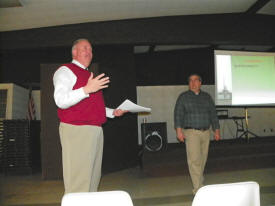 The committee and its
purpose The committee and its
purposeThe committee's goal was to consider the effects and
establish a list of recommendations for Union Pacific and the
Illinois Department of Transportation regarding those issues.
The committee consists of Snyder as co-chair with Darren Forgy of
Prairie Engineers of Illinois, Alderwoman Marty Neitzel, city
engineer Mark Mathon, city police Chief Ken Greenslate, Logan County
EMA director Dan Fulscher, local business owner David Lanterman,
Lisa Kramer of Prairie Engineers of Illinois, Bridget Thomas of
Lincoln College, Wanda Lee Rohlfs of Main Street Lincoln, Joe Ryan
representing the Lincoln/ Logan County Chamber of Commerce, Joel
Smiley of the Lincoln & Logan County Development Partnership, and
Don Begolka representing the Abraham Lincoln Tourism Bureau of Logan
County.
Tuesday evening, the committee held a public information meeting
at the Lincoln Park District facility on Primm Road to share their
findings and recommendations with the community and to gather public
input on those recommendations. Approximately 30 people were in
attendance at the meeting.

The committee's plan includes requests for underpasses, safety
fences, drop-gate crossing arms and a decorative berm through the
heart of the city.
The construction of high-speed rail began in the fall of 2010
with the rehabilitation of rail track and grades from Alton to just
south of Lincoln. In 2011 the construction will continue northward
toward Chicago.
It has been estimated that some high-speed trains will be in
operation as soon as 2012, with the system being fully functional by
2014.
Included in the construction plans are the development of two
side-by-side rail lines running the full distance from Alton to
Chicago and used by Amtrak and Union Pacific.
Once it is fully operational, high-speed trains will pass through
the city of Lincoln at approximately 79 mph and will reach speeds of
110 mph in rural areas.

Snyder said the committee was formed to take a look at the impact
this was going to have on the city. He said the committee wanted to
do their own research and develop their own alternatives to safety
and traffic issues that are inevitable.
According to Forgy of Prairie Engineers, 10 Amtrak trains pass
through Lincoln each day along with six freight trains. Within the
next six years, the number of trains passing through is expected to
rise to 18 Amtrak and 22 freights per day.
Currently trains that come through the city are an average length
of 3,200 feet, but train lengths will double to 6,400 feet in the
future. With those lengths involved, Forgy said there will be points
during each pass through Lincoln when a train is blocking every
railroad crossing in the heart of the city. When those trains stop
or even slow down, there is a potential for serious consequences for
emergency service vehicles.

Underpasses and overpass reconstruction
The committee will recommend two new railroad underpasses in the
city.
The first would involve Wyatt Avenue. Currently Wyatt comes to an
end just east of the tracks, with the city street department
buildings on the west side of the tracks and the current crossing on
Decatur Street.
The committee is looking at closing the Decatur Street crossing
and extending Wyatt Avenue, complete with underpass, to join South
Union Street near Carroll Catholic School.
The second underpass would be located on Keokuk. Forgy said this
is the busiest street in town and that an underpass is necessary
there to keep not only emergency vehicle moving but traffic in
general.
In addition to the new underpasses, the committee is also
planning to ask that the overpass on south to west Kickapoo be
rebuilt. Current standards for railroad overpasses require 23 feet
of clearance from the bottom of the overpass structure to the street
below. The current overpass does not meet that standard, and
vehicles used by the Lincoln Fire Department cannot pass under it as
is.
Forgy said he also has concerns about whether or not the old
structure could handle the increased rail traffic.
Public safety and noise control
With trains coming through the city at high rates of speed,
public safety and pedestrian safety are going to be of great
concern, as well as increased noise.
To address these issues, the committee will ask for an
established "quiet zone" wherein trains will not be permitted to
sound their horns during nighttime hours.
The committee is also asking for the construction of fences in
residential areas and a decorative berm with a wrought-iron fence
atop it in the business district.
Snyder and Forgy talked about what the committee wanted in the
downtown area, saying that the goal had been to come up with a
solution that was pleasing to the eye and fit in aesthetically with
the rest of the city while creating a safety barrier and dampening
the noise levels.
The berm would be built on each side of the track and would run
from Wyatt Avenue to Pekin Street. It would include landscaping and
the addition of trees to help muffle noise, along with angled
parking on one side of the tracks.
Amtrak shelter and loading platforms
It is not yet clear how Amtrak will use the two sets of tracks at
their stop in Lincoln. Snyder said that if the company will be using
both tracks, then there will need to be a loading platform built on
the west side of the tracks at the Amtrak shelter.
In addition, there is a bit of a problem with the current
shelter. For quite some time the city has been trying to negotiate
the purchase of that shelter, which currently sits on property
belonging to the owners of the now-closed Depot Restaurant. Thus far
they have been unsuccessful.
Snyder said that if the city can't make that purchase, then the
committee would like to see a new shelter in a different location.
[to top of second column] |

Comments and questions from the audience
When Forgy and Snyder wrapped up their presentations and opened
the floor for discussion, the first area of concern was for
underpasses versus overpasses.
One attendee commented that underpasses flood in heavy rains,
causing a new set of problems for motorists.
Forgy said that yes they can flood, and there will need to be
good drainage pumps installed in the underpasses.
He added that the advantage of the underpass is visual appeal, in
that overpasses have to be at least 28 feet between the bottom of
the bridge and the rail line below.
When asked about street length involved in an underpass he said
that generally a half block to one block on either side of the
tracks will have to be dug out and regraded for the underpass.
After the meeting David Lanterman added to this, saying that this
distance is far less than what would be needed for an overpass.
Using Keokuk as an example, he said that the grade of an overpass
would have to begin on the west side of North Logan, which would
interfere with that intersection and more of the businesses in the
vicinity, and it would be the same on the east side at the
intersection with Kickapoo.
During the discussion it was asked how this would affect
businesses along the underpass area on Keokuk. The answer: Some
would lose their Keokuk entrance and patrons would have to take
alternative routes.
However, when IDOT and Union Pacific do their official
environmental impact study in Lincoln, they will consider these
types of situations and may offer dollars for relocation of certain
businesses. However, it is most likely that those dollars will go
only to businesses that are completely cut off, with no alternate
route to their business available.

Members of the audience also questioned where the money was
coming from to do all this work.
Currently, IDOT is working with federal dollars provided through
the American Recovery and Reinvestment Act, generally known as
stimulus. Stimulus funds have been provided for what is being called
stage one of the high-speed rail process, which is going on now.
Snyder said that currently stage two is unfunded, though in his
last address to the public, President Barrack Obama did talk about
moving forward with high-speed rail.
The work that will be done in the city will be at the discretion
of IDOT and Union Pacific, and it is expected that they will be the
ones to write the checks.
Forgy said there is always the possibility that the state will
turn money over to the city for some of the projects, but as of now
it is an unknown.
The bottom line is, IDOT and Union Pacific are in control of the
situation and will decide what needs to be done in Lincoln based on
their studies.
However, Snyder said that by forming the committee and making
recommendations or requests, the city is being proactive in their
own future.
Snyder was then asked how good IDOT was being about granting wish
lists, and the answer is that this is uncharted territory for
everyone.
Snyder said that currently Lincoln is about the only place
working on their own wish list, and it comes down to one doesn't
know what they can have until they ask.
Public input, public support
As the meeting drew to an end, the question came from the
audience: "What can we do to help or show our support?"
Snyder said that a show of support was going to be very
important. Currently the committee is asking for public comments on
what they have outlined.
Snyder said that everything is subject to change and public input
is vitally important to the process.
Once the city's requests are finalized, the committee will ask
for letters of support from the public and will have a form letter
available that can be used, or citizens can write their own.

Snyder also commented that the current plan will be an evolving
one. As IDOT conducts studies and the stages of construction
advance, the committee may need to reconsider some of the city's
needs.
Snyder said the committee is hoping to get some good feedback
from the Tuesday night meeting and will meet Feb. 17 to consider
comments made at the meeting and comments received afterward.
In March the committee will make their presentation to the city
council and the Logan County Board and will then file their requests
with IDOT.
Anyone who has suggestions or concerns is urged to contact the
committee and can do so by following the links for Mayor Keith
Snyder on the city of Lincoln website, or by contacting any member
of the committee.
[By NILA SMITH]
Past related article
Related links

 |